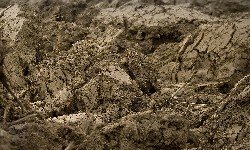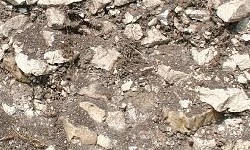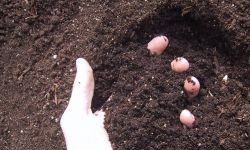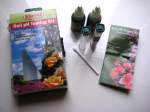Home › Garden soil › Types of soil
The Main Types Of Soil
The major types of soil all have different characteristics and properties and identifying your own soil type is an essential step towards enjoying easier, more rewarding, gardening.
For example, many plants have a marked preference for a particular soil type, so if you know which type you have, you can choose plants that you know will do well.
Similarly, the best methods to use for improving or amending your garden soil are also dependent on soil type - so don't waste your time and energy using techniques that just won't work.
As always, unless you are a glutton for punishment, the key to easier gardening is to work with nature.
So take a quick look at the main types of soil you are likely to encounter, together with the advantages and disadvantages of each type, and then work out which type of soil you have in your own garden.
Broadly speaking, garden soils fall into six main categories, each named after the main constituents. Use the links below to jump down the page for a more detailed description of each type:
Clay Soil | Silty Soil | Sandy Soil | Chalk Soil | Peat Soil | Loam
Types of Soil: Clay

Clay soils contain very fine, flat particles which tend to stick together. They feel heavy and sticky and form a little ball when you rub a small amount between finger and thumb.
A handful of damp clay will retain the impression of your fingers and may appear shiny on the surface.
Disadvantages: When wet they are sticky and hard to work, and when dry they set hard and crack. They are prone to waterlogging and tend to warm up later in the spring than more open sandy soils.
Advantages: They are usually very rich in nutrients and their texture and workability can be improved by adding grit and bulky, very well rotted, organic matter. Improved clay soils will support quite a wide variety of plants.
Types of Soil: Silt

Silty soils fall between clay and sand in terms of particle size, and feel smooth, silky or soapy when rubbed between your fingers.
They may form a fairly cohesive ball in the palm of your hand although they cannot be moulded in the same way as clay.
Disadvantages: When wet they tend to pack down and become heavy, cold and poorly drained rather like clay, although not to the same extent. They warm up quicker than clays but more slowly than sandy soils.
Advantages: They are generally quite fertile and will support a wide range of plants.
Types of Soil: Sand

Sandy soils have a much larger particle size than clays and silts and feel quite gritty between your fingers.
If you squeeze them when wet they don't usually hold their shape.
Disadvantages: The larger particle size means they are very free draining and tend to lose nutrients easily.
Advantages: They are easy to work and warm up quickly in spring so you can get your season off to a flying start. The texture and fertility can be improved by adding rich organic matter.
Types of Soil: Chalk

Chalk soils were described by Geoff Hamilton as 'pale and hungry looking' which sums them up really well! They feel dry and crumbly in your hand, are usually greyish white in colour, and contain fragments of white chalk.
A ball of chalky soil will collapse into fairly large particles.
Disadvantages: They tend to be very stony and shallow and will not support deep rooted plants. They are very free draining and lose nutrients easily. Importantly, these types of soil are also very alkaline and will not support acid loving plants.
Advantages: They can be improved with the addition of organic matter and are reasonably fertile. There is also a good range of lime tolerant plants.
Types of Soil: Peat

Peat soils have a very high organic content so are very dark, almost black, in colour. In your hand they feel moist and spongy and are hard to roll into a ball.
If you look closely you will see that they contain many fibrous plant remains. It is relatively rare to find pure peat in a garden - after all, who would build a house on a peat bog?
Disadvantages: In general they easily become waterlogged and are usually acidic so you will not be able to grow lime loving plants. The acidity also means that they support only a limited range of beneficial soil organisms.
Advantages: They are potentially very fertile and can be cultivated quite intensively. The addition of lime to selected areas will enable you to grow fruit and vegetables. You can make the most of your ornamental garden by growing the many beautiful acid loving plants.
Types of Soil: Loam

In practice, most cultivated soils fall somewhere in between these broad categories and are a blend of different particle sizes. These types of soil are known as 'loams'.
The main characteristics of these loams are those of the predominant mineral.
Disadvantages: Clay loams tend to be heavy and slow draining and are difficult to work when wet. In very dry conditions they harden and form surface cracks.
Sandy loams, on the other hand, are free draining. They are quite easy to work but dry out easily and nutrients are quickly lost.
Silty loams are prone to compaction and tend to settle into a dense airless mass.
Advantages: The fact that loams contain a broader range of particle sizes means that they do not display the extreme characteristics and behaviour of, say, a pure clay or sandy soil, and are easier to work with.
Home › Garden soil › Types of soil
